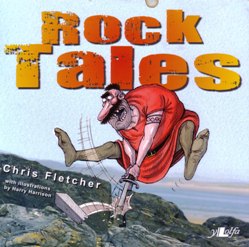
ROCK TALES
Are upright pinnacles of rock strewn across an Anglesey beach the remains of a giant game of skittles, or were they left behind after ice, wind, rain and waves had eroded the surrounding rock? Do patterns covering rock surfaces along a beach represent ancient mudflats, or the skin of a dragon? In ‘Rock Tales’, Chris Fletcher leaves us to make up our own minds, explaining both myth and science with the help of Harry Harrison’s quirky drawings.
Some might see this as a confusing way to introduce children to geology, but analogy is a powerful tool in communicating science. Stories about the formation of a landscape, some of which have been passed down over centuries, not only help the memory, but remind us that landscapes have a human, as well as a geological past.
The book takes us on a tour of the geology of Anglesey, with sketch maps pointing out the geological features as well as local places of interest. The foreword encourages readers to take the book with them when exploring the landscape, and the parallel stories are intended to be viewed in front of the features described.
The mythological stories all refer to a family of giants, along with their pets, and are presented alongside a geological explanation of the feature. These can be a bit high-level at times – terms like ‘cleavage’, ‘fold axis’ and ‘percolated’ could do with some simplification; but there are plenty of sketch diagrams, photographs and cartoons alongside the text to help. These are a great combination of the technical and artistic, and are a useful introduction to the idea of interpreting landscape through diagrams.
Mythological explanations are a good way to remind us that interpretations of the geology around us have changed over time, but I would have liked to know more about the origin of these stories, and whether they were the work of the author, established mythology, or a mixture of both. Similarly, there is no clear target age-group for the book – although, if it is intended as a tool for holidaying families this might be an advantage. There is something for every age here, children as well as adults.
At times the layout can be confusing, as is the use of italics to differentiate between the stories; but this is clearly a book to be read aloud outdoors rather than pored over at a desk. It is a great concept, which I hope we will see more of in the future.
Reviewed by Sarah Day
ROCK TALES
CHRIS FLETCHER Published by Y Lolfa, 2011; ISBN 978-1-84771-380-3 (pbk) 71pp
List price: £6.95
www.ylolfa.com